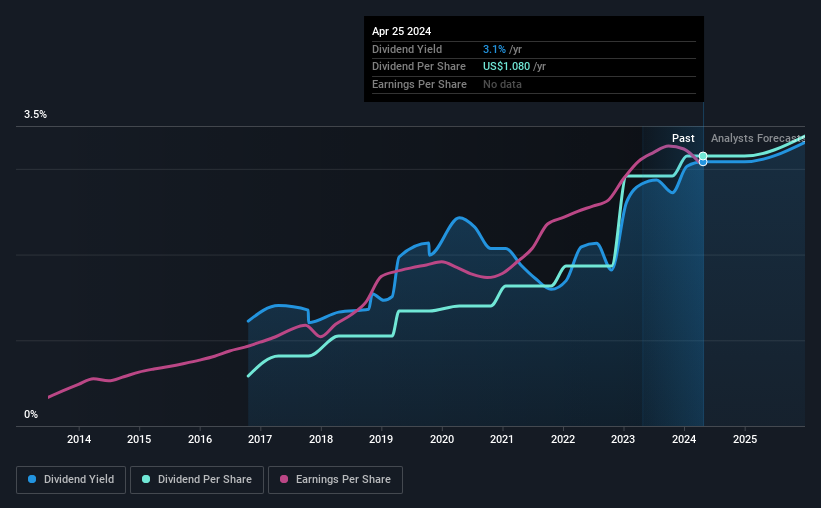Plumas Bancorp (NASDAQ:PLBC) Passed Our Checks, And It's About To Pay A US$0.27 Dividend
Readers hoping to buy Plumas Bancorp (NASDAQ:PLBC) for its dividend will need to make their move shortly, as the stock is about to trade ex-dividend. The ex-dividend date is one business day before a company's record date, which is the date on which the company determines which shareholders are entitled to receive a dividend. The ex-dividend date is of consequence because whenever a stock is bought or sold, the trade takes at least two business day to settle. Accordingly, Plumas Bancorp investors that purchase the stock on or after the 30th of April will not receive the dividend, which will be paid on the 15th of May.
The company's next dividend payment will be US$0.27 per share. Last year, in total, the company distributed US$1.08 to shareholders. Calculating the last year's worth of payments shows that Plumas Bancorp has a trailing yield of 3.1% on the current share price of US$35.04. If you buy this business for its dividend, you should have an idea of whether Plumas Bancorp's dividend is reliable and sustainable. That's why we should always check whether the dividend payments appear sustainable, and if the company is growing.
View our latest analysis for Plumas Bancorp
If a company pays out more in dividends than it earned, then the dividend might become unsustainable - hardly an ideal situation. Plumas Bancorp is paying out just 21% of its profit after tax, which is comfortably low and leaves plenty of breathing room in the case of adverse events.
Generally speaking, the lower a company's payout ratios, the more resilient its dividend usually is.
Click here to see how much of its profit Plumas Bancorp paid out over the last 12 months.
Have Earnings And Dividends Been Growing?
Stocks in companies that generate sustainable earnings growth often make the best dividend prospects, as it is easier to lift the dividend when earnings are rising. If business enters a downturn and the dividend is cut, the company could see its value fall precipitously. Fortunately for readers, Plumas Bancorp's earnings per share have been growing at 12% a year for the past five years.
Many investors will assess a company's dividend performance by evaluating how much the dividend payments have changed over time. Plumas Bancorp has delivered an average of 23% per year annual increase in its dividend, based on the past eight years of dividend payments. Both per-share earnings and dividends have both been growing rapidly in recent times, which is great to see.
The Bottom Line
Should investors buy Plumas Bancorp for the upcoming dividend? Typically, companies that are growing rapidly and paying out a low fraction of earnings are keeping the profits for reinvestment in the business. This is one of the most attractive investment combinations under this analysis, as it can create substantial value for investors over the long run. We think this is a pretty attractive combination, and would be interested in investigating Plumas Bancorp more closely.
While it's tempting to invest in Plumas Bancorp for the dividends alone, you should always be mindful of the risks involved. To help with this, we've discovered 2 warning signs for Plumas Bancorp (1 can't be ignored!) that you ought to be aware of before buying the shares.
Generally, we wouldn't recommend just buying the first dividend stock you see. Here's a curated list of interesting stocks that are strong dividend payers.
Have feedback on this article? Concerned about the content? Get in touch with us directly. Alternatively, email editorial-team (at) simplywallst.com.
This article by Simply Wall St is general in nature. We provide commentary based on historical data and analyst forecasts only using an unbiased methodology and our articles are not intended to be financial advice. It does not constitute a recommendation to buy or sell any stock, and does not take account of your objectives, or your financial situation. We aim to bring you long-term focused analysis driven by fundamental data. Note that our analysis may not factor in the latest price-sensitive company announcements or qualitative material. Simply Wall St has no position in any stocks mentioned.

 Yahoo Finance
Yahoo Finance 
